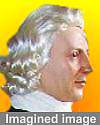
On 18 Jul 1720, Gilbert White was born, the English clergyman and naturalist whose much-loved book, The Natural History and Antiquities of Selbourne, has been continuously in print since it was published in 1789. He has been called the first ecologist for his extensive, detailed observations of his region's flora and fauna, made over a period of 20 years, and collected in this book. For more about this fascinating gentleman, read this article on Gilbert White.
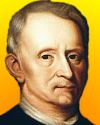
On 18 Jul 1635, Robert Hooke was born, the English physicist who remains very well-known for his law of elasticity, Hooke's Law. Yet he did so much more. Hooke was a virtuoso scientist whose scope of research ranged widely, including physics, astronomy, chemistry, biology, geology, architecture and naval technology. On 5 Nov 1662, Hooke was appointed the Curator of Experiments at the Royal Society, London. After the Great Fire of London (1666), he served as Chief Surveyor and helped rebuild the city. He invented the balance spring for clocks, and also invented or improved meteorological instruments such as the barometer, anemometer, and hygrometer. Hooke authored the influential Micrographia (1665). History has been unkind to Hooke—so brilliant, yet largely forgotten. Today's book pick is: , by who shows us a man of great energy, great diversity, great precision, artistry and his cantankerous personality. This biography of Hooke deserves your attention, as it provides insight on how much he contributed to the growth of science in his era.
It is available from Amazon, typically about (As of earlier time of writing - subject to change.)
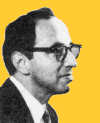 | Each paradigm will be shown to satisfy more or less the criteria that it dictates for itself and to fall short of a few of those dictated by its opponent. |
 | The footsteps of Nature are to be trac'd, not only in her ordinary course, but when she seems to be put to her shifts, to make many doublings and turnings, and to use some kind of art in endeavouring to avoid our discovery. |
 | Earthworms, though in appearance a small and despicable link in the chain of nature, yet, if lost, would make a lamentable chasm … worms seem to be the great promoters of vegetation, which would proceed but lamely without them. [Showing an early awareness in ecology.] |
| Before you look at today's web page, see if you can answer some of these questions about the events that happened on this day. Some of the names are very familiar. Others will likely stump you. Tickle your curiosity with these questions, then check your answers on today's web page. | |
| Births | |
 | On 18 Jul 1720, an English cleric and pioneering naturalist was born in Selborne, Hampshire, known as the “father of English natural history.” In 1789, he published The Natural History and Antiquities of Selborne. The book has been in print continuously since then. It is the first work on natural history to attain the status of an English classic. The text consists of a series of observations, each recorded with a date, covering a 20-year period. The text comes from neither a diary, nor a field book, so why is each of his “monographies” dated? |
 | On 18 Jul 1635, Robert Hooke was born, who discovered the law of elasticity, now known by his name. He was a virtuoso scientist who did research in a remarkable variety of fields. For example, he invented the balance spring for clocks, but also served as Chief Surveyor and helped rebuild London after the Great Fire of 1666. Yet he remains largely unknown today, perhaps because a more famous, but jealous, scientist with whom he quarreled, deliberately worked to overshadow him. Can you name the famous scientist with whom Hooke quarreled? |
| Deaths | |
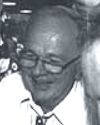 | Eugene Shoemaker (1928-1997) was an American planetary geologist, who initiated and vigorously promoted the intensive geologic training of the astronauts that made them able scientific observers and reporters on moon landings. He co-discovered Comet P/Shoemaker-Levy 9 which collided with Jupiter (1994). He died in a car crash. He was remembered after his death by a remarkable tribute. What was remarkable about this tribute? |
| Events | |
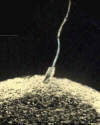 | On 18 Jul 1994, Rosanna Della Corte, an Italian woman, gave birth to a healthy son, Riccardo. Her egg was artificially imseminated by her husband’s sperm, by Dr. Severino Antinori at his fertility clinic in Rome, Italy. At what remarkable age did she give birth? |
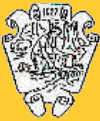 | On 18 Jul 1627, French explorers noticed oil seeping out of the ground. The phenomenon was described by the Franciscan Missionary Joseph DeLa Roch D’Allion, which was the first recorded mention of oil on the North American Continent. The Seneca Oil Spring is located near the spillway end of Cuba Lake on the Oil Spring Indian Reservation. In which State was this oil seepage found? |
Fast answers for the previous newsletter for July 17: light amplification by stimulated emission of radiation • three-point lap and shoulder seat belt • Henri Poincaré • Tanganyika (now Tanzania, East Africa) • Chicago River, Chicago • Humber Bridge.
 If you enjoy this newsletter, the website, or wish to offer encouragement or ideas, please send feedback by using your mail reader Reply button.
If you enjoy this newsletter, the website, or wish to offer encouragement or ideas, please send feedback by using your mail reader Reply button. Your click on a Facebook, StumbleUpon, or other social button on the site webpages is also a welcome sign of appreciation. Thank you for using them.
© This newsletter is copyright 2020 by todayinsci.com. Please respect the Webmaster's wishes and do not put copies online of the Newsletter — or any Today in Science History webpage. (If you already have done so, please remove them. Thank you.) Offline use in education is encouraged such as a printout on a bulletin board, or projected for classroom viewing. Online, descriptive links to our pages are welcomed, as these will provide a reader with the most recent revisions, additions and/or corrections of a webpage. For any other copyright questions, please contact the Webmaster by using your mail reader Reply button.
--
If you do not want to receive any more newsletters, Unsubscribe
To update your preferences and to unsubscribe visit this link
Executive Real Estate Business Class
-
"It was like a man with wings. It wasn't like anything you'd see on TV or in a monster movie." ...
About the publisher
Search This Blog
Blog Archive
-
▼
2020
(1542)
-
▼
July
(200)
- PHOTOGRAPHY: The danger of documenting sharks
- Meet The Serial Killer Who Ate His Victims Because...
- The Roundup Top Ten from History News Network
- On This Day for July 31 - Lunar Roving Vehicle fir...
- Newsletter for Friday 31 July.
- Lockdowns killing more children than COVID + Docto...
- YOUR WEEKLY ESCAPE: Revisiting an iconic Nat Geo c...
- July 31: The Pilgrim Fathers Depart and the Battle...
- ANIMALS: The dog that got COVID-19
- On This Day for July 30 - Death of Otto von Bismar...
- Newsletter for Thursday 30 July.
- Frontline Docs 2nd Video Press Conf at SCOTUS We h...
- BREAKING NEWS: First U.S. dog to test positive for...
- July 30: First Defenestration of Prague, the 1st O...
- Demystified: Why Do Wolves Howl?
- The Champs Are Back on Forged in Fire Tonight
- SCIENCE: A rush to Mars during a rough patch at home
- Breaking News from History News Network
- On This Day for July 29 - National Aeronautics and...
- Newsletter for Wednesday 29 July.
- All Social Media Censor Frontline Docs COVID Video...
- July 29: Spanish Armada Scattered and Taft's Secre...
- TRAVEL: How to stay safe if you need to travel
- On This Day for July 28 - Beginning of World War I...
- Newsletter for Tuesday 28 July.
- Video Presentation from Washington Summit: America...
- July 28: Robespierre Guillotined, Austria-Hungary ...
- HISTORY: How the vice presidency became critical
- Enjoy Summer with Nat Geo Kids Magazine
- New This Week on History News Network
- On This Day for July 27 - Terrorist attack at Atla...
- Newsletter for Monday 27 July.
- COVID Propaganda & Tyrannical Edicts Affecting Men...
- July 27: Walter Raleigh Brings Tobacco, the Atlant...
- FAMILY: Can you transfer your ‘retro fun’ to your...
- The 10 greatest discoveries made by the British pu...
- On This Day for July 26 - Suez Canal seized, John ...
- Newsletter for Sunday 26 July.
- CDC says actual # of cases is up to 13X higher tha...
- July 26: 1st Muslim Civil War, Pizarro's Royal Cha...
- The Compass: Greece
- On This Day for July 25 - American advance into Ca...
- Newsletter for Saturday 25 July.
- VIRUS UPDATE: What does COVID-19 do to a child's b...
- July 25: The 1st Steam Locomotive, Mussolini Dismi...
- PHOTOGRAPHY: The photo that shocked a nation
- This Hardened Blob Of Nuclear Waste Could Kill You...
- On This Day for July 24 - Beginning of Mata Hari's...
- The Roundup Top Ten From History News Network
- Newsletter for Friday 24 July.
- Medical Journal: make the vaccine Mandatory! + Fre...
- YOUR WEEKLY ESCAPE: The man who claims to be Jesus...
- July 24: Cartier Lands in Canada, Mary Queen of Sc...
- ANIMALS: Let’s not forget this other catastrophe
- Demystified: Are Dogs Really Color-Blind?
- On This Day for July 23 - Egyptian monarchy topple...
- Newsletter for Thursday 23 July.
- listen to Dixie Brogdon Hopson tells how the hospi...
- July 23: Upper and Lower Canada United and the Bre...
- SCIENCE: The joy of vintage comforts
- A Puzzling Challenge on Forged in Fire Tonight
- Explore King Tut's tomb with National Geographic H...
- Breaking News from History News Network
- On This Day for July 22 - Deng Xiaoping reinstated...
- CDC Knows Masks and other methods don't work to st...
- Newsletter for Wednesday 22 July.
- July 22: First Congress of Vienna and Spoonerism
- TRAVEL: When tourism returns will it be better?
- Enjoy Summer with Nat Geo Kids Magazine
- On This Day for July 21 - Egyptians defeated in th...
- Newsletter for Tuesday 21 July.
- July 21: 1st Battle of Bull Run, the Trans-Siberia...
- HISTORY: John Lewis always stood for the same thing
- New This Week on History News Network
- On This Day for July 20 - First Moon landing, Sir ...
- Newsletter for Monday 20 July.
- What Scientific Study Shows 6 feet distance or "ma...
- July 20: On This Day in History
- FAMILY: Searching for patience
- Anne of Cleves: Henry VIII's most successful queen?
- On This Day for July 19 - U.S. women's suffrage mo...
- Newsletter for Sunday 19 July.
- Mask Truth Part 2, Data by Nations shows Hydroxych...
- July 19: 1st US Women's Rights Convention and V fo...
- The Compass: Colombia
- On This Day for July 18 - Publication of Mein Kamp...
- Newsletter for Saturday 18 July.
- Enough! Mask Truth, re-Creating you! the intended...
- CORONAVIRUS SPECIAL EDITION: What type of person d...
- July 18: Spanish Civil War Begins and 7 Years of K...
- PHOTOGRAPHY: Showing a nation losing its drinking ...
- How Julia Child Went From World War 2 Spy To Belov...
- Introducing Expedition: Learn! A New Way to Help K...
- The Roundup Top Ten for July 17, 2020
- On This Day for July 17 - Beginning of the Spanish...
- Newsletter for Friday 17 July.
- July 17: Execution of the Romanovs and a Stormy Bi...
- YOUR WEEKLY ESCAPE: An intimate look inside a mode...
- ANIMALS: The trouble with 'retired' chimps
- Man vs. 800-Pound Beast! Watch New Episode of Alon...
-
▼
July
(200)
-
Blogroll
-
About
HistoryFact










0 comments:
Post a Comment